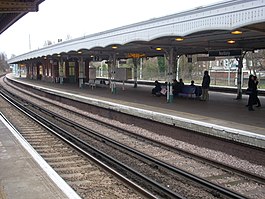Norbury railway station
| Norbury | |
|---|---|
 | |
| Location | Norbury |
| Local authority | London Borough of Croydon |
| Managed by | Southern |
| Station code(s) | NRB |
| DfT category | C2 |
| Number of platforms | 4 (2 of which are rarely used) |
| Accessible | Yes[1] |
| Fare zone | 3 |
| National Rail annual entry and exit | |
| 2004–05 | 1.465 million[2] |
| 2005–06 | |
| 2006–07 | |
| 2007–08 | |
| 2008–09 | |
| 2009–10 | |
| 2010–11 | |
| 2011–12 | |
| 2012–13 | |
| 2013–14 | |
| 2014–15 | |
| Key dates | |
| 1878 | Opened |
| Other information | |
| External links | |
Norbury railway station is in the London Borough of Croydon in south London 7.5 miles (12 km) miles from Victoria.[3] The station is operated by Southern, who also provide the majority of services (the only exceptions being two early morning departures operated by Thameslink[4]) and is in Travelcard Zone 3.
Ticket barriers are in operation at this station.
Service
The typical off-peak train service per hour is:
- 6 to London Victoria via Balham
- 2 to London Bridge via Tulse Hill and Peckham Rye
- 2 to Caterham via East Croydon
- 2 to West Croydon
- 2 to Sutton
- 1 to East Croydon
- 1 to Epsom via Sutton
- 1 to Epsom Downs via Sutton
- 1 to Milton Keynes Central via Kensington Olympia
History
The Balham Hill and East Croydon line was constructed by the London Brighton and South Coast Railway (LB&SCR) as a short-cut on the Brighton Main Line to London Victoria, avoiding Crystal Palace and Norwood Junction. It was opened on 1 December 1862.[6] Norbury station was not however opened until January 1878, as the surrounding area was very rural.[7] The station was rebuilt in 1903 when the lines were quadrupled.[8] In 1912 the lines were electrified.[9]
Ticket gates were installed in 2009.
A Victorian racetrack, dating from 1868, held the ‘Streatham Races’ in the fields (which were the sports ground of the National Westminster/NatWest Bank) that formed part of the old Lonesome Farm. The race meetings attracted huge crowds of racegoers, bookies and other notorious characters. The course also included a water jump across the River Graveney. Sadly, this exciting but disreputable period of history came to an end in 1878 when the Racecourse Licensing Act banned racecourses within a radius of 10 miles of London.
Connections
London Buses routes 50, 109 and 255 and night route N109 serve the station.
References
- ^ "London and South East" (PDF). National Rail. September 2006. Archived from the original (PDF) on 6 March 2009.
- ^ a b c d e f g h i j k "Estimates of station usage". Rail statistics. Office of Rail Regulation. Please note: Some methodology may vary year on year.
- ^ Body, Geoffrey (1989). PSL field guide to the railways of Southern Region. Wellingborough: Patrick stephens Ltd. p. 171. ISBN 1-85260-297-X.
- ^ FCC. "First Capital Connect Timetable - Table 3 - Sutton and Wimbledon to London" (PDF).
- ^ http://www.southernrailway.com
- ^ Turner, John Howard (1978). The London Brighton and South Coast Railway 2 Establishment and Growth. Batsford. ISBN 0-7134-1198-8. p. 126-8.
- ^ Turner, John Howard (1979). The London Brighton and South Coast Railway 3 Completion and Maturity. Batsford. ISBN 0-7134-1389-1. p. 144-8.
- ^ Turner (1979), p. 149.
- ^ Turner, J.T. Howard (1979) pp.91, 177-8.
External links
- Train times and station information for Norbury railway station from National Rail
| Preceding station | Following station | |||
|---|---|---|---|---|
- Use dmy dates from August 2012
- Rail transport stations in London fare zone 3
- DfT Category C2 stations
- Railway stations in Croydon
- Former London, Brighton and South Coast Railway stations
- Railway stations opened in 1878
- Railway stations served by Southern
- 1878 establishments in England
- London railway station stubs
